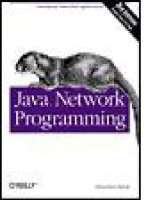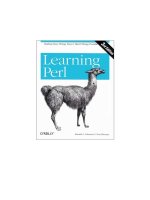Learning Java, 3rd Edition pdf
Bạn đang xem bản rút gọn của tài liệu. Xem và tải ngay bản đầy đủ của tài liệu tại đây (21.86 MB, 8,582 trang )
Learning Java, 3rd Edition
Table of Contents
Copyright
Preface
New Developments
Using This Book
Online Resources
Conventions Used in This Book
Using Code Examples
Safari Enabled
How to Contact Us
Acknowledgments
Chapter 1. A Modern
Language
Section 1.1. Enter Java
Section 1.2. A Virtual Machine
Section 1.3. Java Compared
with Other Languages
Section 1.4. Safety of Design
Section 1.5. Safety of
Implementation
Section 1.6. Application and
User-Level Security
Section 1.7. Java and the Web
Section 1.8. Java as a General
Application Language
Section 1.9. A Java Road Map
Chapter 2. A First Application
Section 2.1. Java Tools and
Environment
Section 2.2. HelloJava
Section 2.3. HelloJava2: The
Sequel
Section 2.4. HelloJava3: The
Button Strikes!
Section 2.5. HelloJava4:
Netscape's Revenge
Section 2.6. Troubleshooting
Chapter 3. Tools of the Trade
Section 3.1. The Java VM
Section 3.2. Running Java
Applications
Section 3.3. The Classpath
Section 3.4. The Java Compiler
Section 3.5. JAR Files
Section 3.6. Policy Files
Chapter 4. The Java Language
Section 4.1. Text Encoding
Section 4.2. Comments
Section 4.3. Types
Section 4.4. Statements and
Expressions
Section 4.5. Exceptions
Section 4.6. Assertions
Section 4.7. Arrays
Chapter 5. Objects in Java
Section 5.1. Classes
Section 5.2. Methods
Section 5.3. Object Creation
Section 5.4. Object Destruction
Section 5.5. Enumerations
Chapter 6. Relationships
Among Classes
Section 6.1. Subclassing and
Inheritance
Section 6.2. Interfaces
Section 6.3. Packages and
Compilation Units
Section 6.4. Visibility of
Variables and Methods
Section 6.5. Arrays and the
Class Hierarchy
Section 6.6. Inner Classes
Chapter 7. Working with
Objects and Classes
Section 7.1. The Object Class
Section 7.2. The Class Class
Section 7.3. Reflection
Section 7.4. Annotations
Chapter 8. Generics
Section 8.1. Containers:
Building a Better Mousetrap
Section 8.2. Enter Generics
Section 8.3.
Section 8.4. Parameterized
Type Relationships
Section 8.5. Casts
Section 8.6. Writing Generic
Classes
Section 8.7. Bounds
Section 8.8. Wildcards
Section 8.9. Generic Methods
Section 8.10. Arrays of
Parameterized Types
Section 8.11. Case Study: The
Enum Class
Section 8.12. Case Study: The
sort( ) Method
Section 8.13. Conclusion
Chapter 9. Threads
Section 9.1. Introducing
Threads
Section 9.2. Threading an
Applet
Section 9.3. Synchronization
Section 9.4. Scheduling and
Priority
Section 9.5. Thread Groups
Section 9.6. Thread
Performance
Section 9.7. Concurrency
Utilities
Section 9.8. Conclusion
Chapter 10. Working with Text
Section 10.1. Text-Related
APIs
Section 10.2. Strings
Section 10.3.
Internationalization
Section 10.4. Parsing and
Formatting Text
Section 10.5. Printf-Style
Formatting
Section 10.6. Formatting with
the java.text Package
Section 10.7. Regular
Expressions
Chapter 11. Core Utilities
Section 11.1. Math Utilities
Section 11.2. Dates and Times
Section 11.3. Timers
Section 11.4. Collections
Section 11.5. Properties
Section 11.6. The Preferences
API
Section 11.7. The Logging API
Section 11.8. Observers and
Observables
Chapter 12. Input/Output
Facilities
Section 12.1. Streams
Section 12.2. Files
Section 12.3. Serialization
Section 12.4. Data
Compression
Section 12.5. The NIO
Package
Chapter 13. Network
Programming
Section 13.1. Sockets
Section 13.2. Datagram
Sockets
Section 13.3. Simple Serialized
Object Protocols
Section 13.4. Remote Method
Invocation
Section 13.5. Scalable I/O with
NIO
Chapter 14. Programming for
the Web
Section 14.1. Uniform
Resource Locators (URLs)
Section 14.2. The URL Class
Section 14.3. Talking to Web
Applications
Section 14.4. Web Services
Chapter 15. Web Applications
and Web Services
Section 15.1. Web Application
Technologies
Section 15.2. Web Applications
Section 15.3. WAR Files and
Deployment
Section 15.4. Servlet Filters
Section 15.5. Building WAR
Files with Ant
Section 15.6. Implementing
Web Services
Chapter 16. Swing
Section 16.1. Components
Section 16.2. Events
Section 16.3. Event Summary
Section 16.4. The AWT Robot!
Section 16.5. Multithreading in
Swing
Chapter 17. Using Swing
Components
Section 17.1. Buttons and
Labels
Section 17.2. HTML Text in
Buttons and Labels
Section 17.3. Checkboxes and
Radio Buttons
Section 17.4. Lists and Combo
Boxes
Section 17.5. The Spinner
Section 17.6. Borders
Section 17.7. Menus
Section 17.8. Pop-up Menus
Section 17.9. Component-
Managed Pop-ups
Section 17.10. The JScrollPane
Class
Section 17.11. The JSplitPane
Class
Section 17.12. The
JTabbedPane Class
Section 17.13. Scrollbars and
Sliders
Section 17.14. Dialogs
Section 17.15. File Selection
Dialog
Section 17.16. The Color
Chooser
Chapter 18. More Swing
Components
Section 18.1. Text
Components
Section 18.2. Focus Navigation
Section 18.3. Tables
Section 18.4. Desktops
Section 18.5. Pluggable Look-
and-Feel
Section 18.6. Creating Custom
Components
Chapter 19. Layout Managers
Section 19.1. FlowLayout
Section 19.2. GridLayout
Section 19.3. BorderLayout
Section 19.4. BoxLayout
Section 19.5. CardLayout
Section 19.6. GridBagLayout
Section 19.7. Nonstandard
Layout Managers
Section 19.8. Absolute
Positioning
Section 19.9. SpringLayout
Chapter 20. Drawing with the
2D API
Section 20.1. The Big Picture
Section 20.2. The Rendering
Pipeline
Section 20.3. A Quick Tour of
Java 2D
Section 20.4. Filling Shapes
Section 20.5. Stroking Shape
Outlines
Section 20.6. Using Fonts
Section 20.7. Displaying
Images
Section 20.8. Drawing
Techniques
Section 20.9. Printing
Chapter 21. Working with
Images and Other Media
Section 21.1. Loading Images
Section 21.2. Producing Image
Data
Section 21.3. Filtering Image
Data
Section 21.4. Saving Image
Data
Section 21.5. Simple Audio
Section 21.6. Java Media
Framework
Chapter 22. JavaBeans
Section 22.1. What's a Bean?
Section 22.2. The NetBeans
IDE
Section 22.3. Properties and
Customizers
Section 22.4. Event Hookups
and Adapters
Section 22.5. Binding
Properties
Section 22.6. Building Beans
Section 22.7. Limitations of
Visual Design
Section 22.8. Serialization
Versus Code Generation
Section 22.9. Customizing with
BeanInfo
Section 22.10. Hand-Coding
with Beans
Section 22.11. BeanContext
and BeanContextServices
Section 22.12. The Java
Activation Framework
Section 22.13. Enterprise
JavaBeans
Chapter 23. Applets
Section 23.1. The Politics of
Applets
Section 23.2. The JApplet
Class
Section 23.3. Using the Java
Plug-in
Section 23.4. Java Web Start
Section 23.5. Using Digital
Signatures
Section 23.6. Conclusion
Chapter 24. XML
Section 24.1. A Bit of
Background
Section 24.2. XML Basics
Section 24.3. SAX
Section 24.4. DOM
Section 24.5. XPath
Section 24.6. XInclude
Section 24.7. Validating
Documents
Section 24.8. JAXB and Code
Generation
Section 24.9. Transforming
Documents with XSL/XSLT
Section 24.10. Web Services
Section 24.11. The End of the
Book
Appendix A. The Eclipse IDE
Section A.1. The IDE Wars
Section A.2. Getting Started
with Eclipse
Section A.3. Using Eclipse
Section A.4. Eclipse Features
Section A.5. Conclusion
Appendix B. BeanShell: Simple
Java Scripting
Section B.1. Running
BeanShell
Section B.2. Java Statements
and Expressions
Section B.3. BeanShell
Commands
Section B.4. Scripted Methods
and Objects









